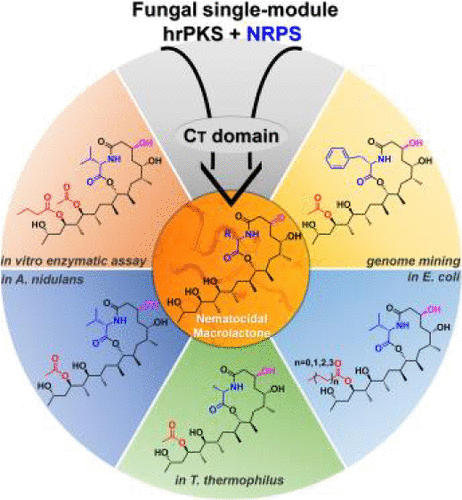当前位置:
X-MOL 学术
›
J. Am. Chem. Soc.
›
论文详情
Our official English website, www.x-mol.net, welcomes your
feedback! (Note: you will need to create a separate account there.)
Heterologous- and engineered- biosynthesis of nematocidal polyketide-nonribosomal peptide hybrid macrolactone from extreme thermophilic fungi
Journal of the American Chemical Society ( IF 14.4 ) Pub Date : 2020-01-06 , DOI: 10.1021/jacs.9b11410 Jin-Mei Zhang 1 , Hang-Hang Wang 1 , Xuan Liu 1 , Chang-Hua Hu 1 , Yi Zou 1
Journal of the American Chemical Society ( IF 14.4 ) Pub Date : 2020-01-06 , DOI: 10.1021/jacs.9b11410 Jin-Mei Zhang 1 , Hang-Hang Wang 1 , Xuan Liu 1 , Chang-Hua Hu 1 , Yi Zou 1
Affiliation

|
Fungal polyketide-nonribosomal peptide (PK-NRP) hybrid macrolactones are a growing family of natural products with biomedical and agricultural activities. One of the most important families is the thermolides, which are produced by extreme thermophilic fungi and exhibit strong nematocidal activity. We show here that the genes ThmABCE from Talaromyces thermophilus NRRL 2155 are critical for thermolide synthesis. Two separate single-module hrPKS (ThmA) and NRPS (ThmB) enzymes collaborate to synthesize the core macrolactone backbone (6 or 7), and the NRPS ThmB-CT domain catalyzes the key macrocyclization step in PK-NRP intermediate release via ester bond formation, representing a novel function of fungal NRPS C domains. We also show that heterologous and engineered expression of the Thm genes in the type strains of Aspergillus nidulans and Escherichia coli not only dramatically enhances the yields of thermolides but also affords different esterified analogues, such as butyryl- (thermolides J and K, 15 and 16), hexanoyl-, and octanyl- derivatives or mixed thermolides. Thermolides L and M (18 and 19), discovered via genome mining-based combinatorial biosynthesis, represent the first L-phenylalanine based thermolides. Our work shows a unique biosynthetic mechanism of PK-NRP hybrid macrolactones from extremophiles, which led to the discovery of novel compounds and furthers our biosynthetic knowledge.
中文翻译:

来自极端嗜热真菌的杀线虫聚酮化合物-非核糖体肽杂合大环内酯的异源和工程生物合成
真菌聚酮化合物-非核糖体肽 (PK-NRP) 杂化大环内酯是一个不断增长的天然产品家族,具有生物医学和农业活动。最重要的家族之一是嗜热菌,它们由极端嗜热真菌产生并具有很强的杀线虫活性。我们在这里展示了来自嗜热链节菌 NRRL 2155 的基因 ThmABCE 对热内酯合成至关重要。两个独立的单模块 hrPKS (ThmA) 和 NRPS (ThmB) 酶协作合成核心大环内酯骨架(6 或 7),NRPS ThmB-CT 结构域通过酯键形成催化 PK-NRP 中间体释放的关键大环化步骤,代表真菌 NRPS C 域的新功能。我们还表明,构巢曲霉和大肠杆菌的类型菌株中 Thm 基因的异源和工程表达不仅显着提高了thermolides 的产量,而且还提供了不同的酯化类似物,例如丁酰-(thermolides J 和 K,15 和 16 )、己酰基-和辛基-衍生物或混合热内酯。通过基于基因组挖掘的组合生物合成发现的 Thermolides L 和 M(18 和 19)代表了第一个基于 L-苯丙氨酸的 Thermolides。我们的工作展示了来自极端微生物的 PK-NRP 杂化大环内酯的独特生物合成机制,这导致了新化合物的发现并进一步加深了我们的生物合成知识。己酰基-和辛酰基-衍生物或混合热内酯。通过基于基因组挖掘的组合生物合成发现的 Thermolides L 和 M(18 和 19)代表了第一个基于 L-苯丙氨酸的 Thermolides。我们的工作展示了来自极端微生物的 PK-NRP 杂化大环内酯的独特生物合成机制,这导致了新化合物的发现并进一步加深了我们的生物合成知识。己酰基-和辛酰基-衍生物或混合热内酯。通过基于基因组挖掘的组合生物合成发现的 Thermolides L 和 M(18 和 19)代表了第一个基于 L-苯丙氨酸的 Thermolides。我们的工作展示了来自极端微生物的 PK-NRP 杂化大环内酯的独特生物合成机制,这导致了新化合物的发现并进一步加深了我们的生物合成知识。
更新日期:2020-01-06
中文翻译:

来自极端嗜热真菌的杀线虫聚酮化合物-非核糖体肽杂合大环内酯的异源和工程生物合成
真菌聚酮化合物-非核糖体肽 (PK-NRP) 杂化大环内酯是一个不断增长的天然产品家族,具有生物医学和农业活动。最重要的家族之一是嗜热菌,它们由极端嗜热真菌产生并具有很强的杀线虫活性。我们在这里展示了来自嗜热链节菌 NRRL 2155 的基因 ThmABCE 对热内酯合成至关重要。两个独立的单模块 hrPKS (ThmA) 和 NRPS (ThmB) 酶协作合成核心大环内酯骨架(6 或 7),NRPS ThmB-CT 结构域通过酯键形成催化 PK-NRP 中间体释放的关键大环化步骤,代表真菌 NRPS C 域的新功能。我们还表明,构巢曲霉和大肠杆菌的类型菌株中 Thm 基因的异源和工程表达不仅显着提高了thermolides 的产量,而且还提供了不同的酯化类似物,例如丁酰-(thermolides J 和 K,15 和 16 )、己酰基-和辛基-衍生物或混合热内酯。通过基于基因组挖掘的组合生物合成发现的 Thermolides L 和 M(18 和 19)代表了第一个基于 L-苯丙氨酸的 Thermolides。我们的工作展示了来自极端微生物的 PK-NRP 杂化大环内酯的独特生物合成机制,这导致了新化合物的发现并进一步加深了我们的生物合成知识。己酰基-和辛酰基-衍生物或混合热内酯。通过基于基因组挖掘的组合生物合成发现的 Thermolides L 和 M(18 和 19)代表了第一个基于 L-苯丙氨酸的 Thermolides。我们的工作展示了来自极端微生物的 PK-NRP 杂化大环内酯的独特生物合成机制,这导致了新化合物的发现并进一步加深了我们的生物合成知识。己酰基-和辛酰基-衍生物或混合热内酯。通过基于基因组挖掘的组合生物合成发现的 Thermolides L 和 M(18 和 19)代表了第一个基于 L-苯丙氨酸的 Thermolides。我们的工作展示了来自极端微生物的 PK-NRP 杂化大环内酯的独特生物合成机制,这导致了新化合物的发现并进一步加深了我们的生物合成知识。









































 京公网安备 11010802027423号
京公网安备 11010802027423号